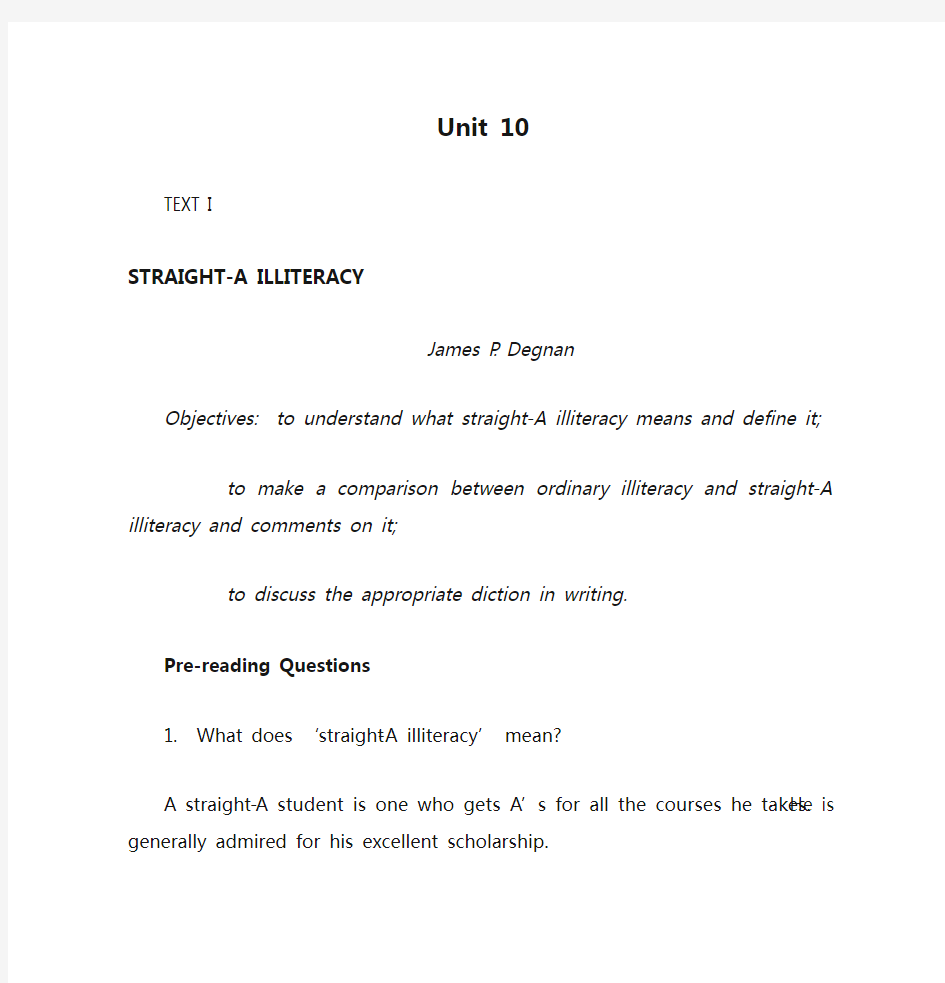新编英语教程 6 Unit 10 教案

- 1、下载文档前请自行甄别文档内容的完整性,平台不提供额外的编辑、内容补充、找答案等附加服务。
- 2、"仅部分预览"的文档,不可在线预览部分如存在完整性等问题,可反馈申请退款(可完整预览的文档不适用该条件!)。
- 3、如文档侵犯您的权益,请联系客服反馈,我们会尽快为您处理(人工客服工作时间:9:00-18:30)。
Unit 10
TEXT I
STRAIGHT-A ILLITERACY
James P. Degnan
Objectives: to understand what straight-A illiteracy means and define it;
to make a comparison between ordinary illiteracy and straight-A illiteracy and comments on it;
to discuss the appropriate diction in writing.
Pre-reading Questions
1. What does ‘straight-A illiteracy’ mean?
A straight-A student is one who gets A’s for all the courses he takes. He is generally admired for his excellent scholarship.
It seems paradoxi cal to call someone a ‘straight-A illiterate’. What does the author mean by it? Read the article and try to understand and define what straight-A illiteracy means.
In-reading Comprehension
Para. 1
1. as often as not: at least half the time; frequently
2. How many kinds of illiterate according to D.?
Two kinds: ordinary illiterates who are unable to read or write. There are quite a lot of this kind of illiterates in schools.
straight-A illiterate who is typically a Ph.D., a successful professor and textbook author, and who is more influential.
3. Why does D say that a straight-A illiterate is more influential? (comp. 3-2)
He is usu. one who occupies a position at the top of the academic hierarchy; the way he writes is considered exemplary, and his judgment of what is appropriate is directive.
4. What do people do with these two kinds of illiterate?
More concern has been shown for the ordinary illiterates. People even make fuss about this kind of illiteracy. However, little attention is aroused to straight-A illiterates. So, the purpose of this article is to give them as much attention as has been paid to ordinary illiterates. (ll. 6-7)
Para. 2
1. What is this para. about?
D’s treatment with a disease of straight-A illiteracy in his office.
2. Do you think D’s comparison of straight-A illiteracy to a disease is appropriate? Explain. (comp. 3-3)
Yes. Like a disease, it victimizes healthy persons; it has its symptoms, and its agents.
3. Who is the straight-A illiterate?
a college senior ... outstanding graduate schools.
He is extremely clever and highly talented in language. He has done an excellent job in his studies, so he has been awarded an opportunity to further his study in one of the nation’s best graduate schools.
4. How does the treatment go?
They have been going over the student’s paper sentence by sentence, word by word for an hour, prying and probing for its meaning.
‘Prying and probing’, the repetition of the same structure, is to emphasize the extreme difficulty of the task.
5. Are there any other words to highlight the extreme difficulty in understanding Mr. Bright’s paper? (comp. 3-4)
interrogating, cross-examining, pause to catch my breath, on earth, his brow furrowed, tries mightily, finally ... finally, another hour, decode ....
6. Try to explain why the following pairs of sentences are the same in meaning: ll. 15-17, ll. 23 (comp. 3-8)
As intended by the student, ‘The choice ... multi-colinearity’ corresponds to ‘demand’ while ‘... the derivations ... coefficients’ corresponds to ‘supply’.
This is a very abstruse sentence to unravel.
7. Why does D insert the word ‘allegorically’ in ‘... whom I call, allegorically,
